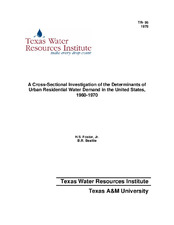| dc.description.abstract | This research was undertaken to specify and estimate a model relating household demand for urban water to its principal determinants. Four specific tasks were accomplished:
1. An appropriate economic demand model for urban-residential water supplies was postulated. An improved specification of the rainfall variable was developed to account for turf maintenance demand. The price of water was specified in exponential form making its elasticity price dependent.
2. Parameters of the model were estimated based on pooled data representing a cross-section of U.S. cities.
3. Parameters were estimated for a regionalized version of the model by incorporating sets of dummy variables. Tests for statistical differences among key economic coefficients were made to ascertain regional differences, if any.
4. Parameters were estimated for a model disaggregated by size-of-city categories again by incorporating dummy variable sets. Tests for statistical differences among key economic coefficients were made to ascertain differences among size-of-city categories, if any.
The demand models were fitted using 1960 and 1970 data and ordinary least squares regression techniques. Explanatory variables included price, income, precipitation (during the defined growing season) and number of residents per meter in addition to sets of dummy variables on the constant factor and price and income coefficients. The results suggest that size of city is not statistically significant in determining the residential demand for urban water. However, regional differences are significant.
For the regional model, price, income, and residents per meter were significant at the 1 percent level for the 1960 data; price and precipitation were significant at the 1 percent level for the 1970 data. R2-values were .74 and .71 for the 1960 and 1970 data, respectively.
Income and price elasticities are presented for all regions at the mean price level and for one standard deviation above and below this price level. Mean price level elasticities ranged between -.30 and -.82 and between -.33 and -.67 for the 1960 and 1970 data, respectively, suggesting an inelastic residential water demand at present price levels. The elasticity estimates derived from the regional coefficients of this study compare favorably with those of earlier more micro-level analyses. | en |


